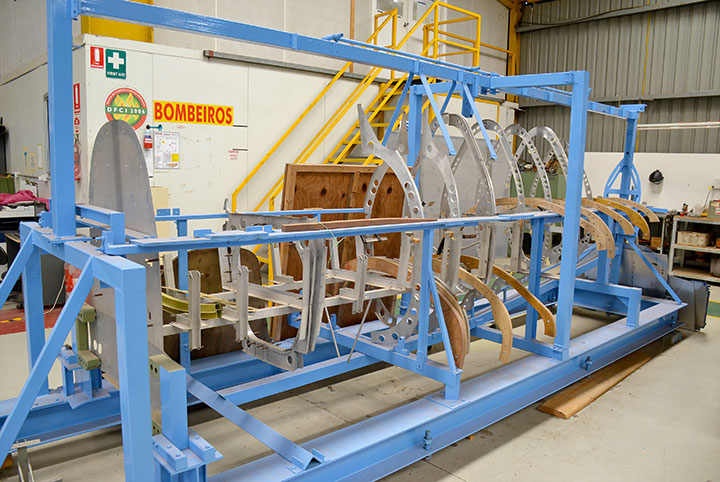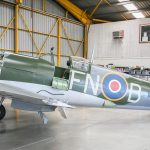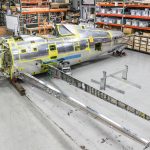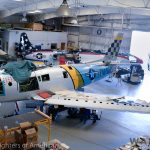We thought our readers would be interested in a piece by our good friend John Parker at Warbirds Online who reports on the arrival of three new restoration projects at Vintage Fighter Restorations (VFR) in Scone, New South Wales, Australia. These include two Supermarine Spitfire Mk.Vc fighters and an even rarer Seafire Mk.XV! We will let John continue the story here…
The three projects have resided in South Australia for some time, however, Ross Pay and Paul Bennet recently purchased the trio, and they arrived for restoration at Scone this week.
The two Spitfires are both former Royal Australian Air Force examples: A58-232 and A58-63, originally constructed for Britain’s Royal Air Force as MA353 and BS164 respectively. The Seafire is a former Royal Navy F Mk.XV which served in the Fleet Air Arm as SW800. Not being ones to sit on their hands, VFR has already commenced the restoration of Spitfire A58-63/BS164 which will remain in Scone with Ross Pay/VFR post restoration. The fuselage has started taking shape in the jig within the workshop. This restoration will be take place completely in house, as VFR has all of the skills and experience required to complete the process. It’s somewhat of a Spitfire production line in their workshop at present, which also houses two Mk IXs, MH415 and MH603, that are both nearing completion. The images below show A58-63 in its jig, and the RAAF aircraft record cards for ’63 and ‘232.
- Spitfire A58-63 in jig
- Spitfire A58-63 restoration
- Spitfire A58-63 Status Card
- Spitfire A58-63 Status Card
A58-63/BS164 is a significant aircraft to Australia’s history, having flown in combat over Australia during WWII. In fact, she was the personal mount of RAAF 54 Squadron’s commanding officer, Squadron Leader Eric M. Gibbs, who is credited with shooting down five and a half Japanese aircraft in this same airframe. The Spitfire was initially coded K and later DL-K and featured 54 Squadrons unique “Nip Glass” “Kill Markings” instead of Japanese rising Sun markings – unique to Australia. For a more detailed look at S/L Gibbs and 54 Squadron’s efforts with Spitfires, please click HERE. VFR will obviously be restoring this Spitfire to exactly the same configuration and markings she wore during the war.
Spitfire BS164 was arguably the most successful Mk Vc to serve in Australia’s Northern Territory. She is a unique and famous representative of the type. She also appeared physically different to the more usual Spitfires of the day, being a “Trop” (tropical) variant. She featured the ungainly-looking Vokes air filter under the “chin” which was designed to protect the Merlin engine from the ingress of sand and grit frequently present in arid locations. RAF/RAAF Spitfires in the Northern Territory also carried the “Slipper” style drop tank when on long range missions and the combination of the Vokes filter resulted in a very different looking Spitfire to the standard Mk V. Later Australian deliveries of Mk V aircraft from the UK came without the Vokes filter fitted and, indeed, some RAAF units removed the system from older aircraft then in service.
Given past experience with the Mk.IX Spitfires, progress on BS164’s fuselage should progress fairly quickly. All of the necessary components are readily available as “kit sets” from companies in the UK. BS164 joined the Australian civil register as VH-CIP.
Work will soon commence on the Mk V wings in the two sets of wing jigs available at Scone, however a set of wings will also be necessary for Ross Pay’s Spitfire MK IX BS548 two-seater, the fuselage of which is under construction in the UK – for a closer look at this aircraft see Supermarine Scramble in Australia. So there will be a queue of activity taking place in the Spitfire wing construction area of the workshop. It is fortunate that the two wing jig sets are on hand to cater for the continuous work.
The next Spitfire in the queue at Scone will be the fuselage of Mk V A58-232 for noted aerobatic pilot Paul Bennet. A58-232 is also a Tropical variant and will probably end up finished in its original 54 Squadron scheme, marked as DL-A. The rebuild will follow exactly the same sequence as A58-63 does. ‘232 is now registered as VH-CIH.
It is anticipated that both Mk V Spitfires will remain and fly in Australia following their restorations.
And now for the story of Supermarine Seafire Mk.XV SW800. This is a very exciting prospect, and will be a long term restoration. Seafires are exceedingly rare, in any variant, and this example is likely to be the only such example available in Australia for the foreseeable future. The Seafire will provide a significant challenge, since it differs enormously from a standard Spitfire. Thus the parts supply for such unique features as the wing-folding mechanism and arresting gear, may proved difficult to resolve. As such, the Seafire is currently available for purchase either as a project “as is” or as an ongoing restoration that VFR can complete per customer requirements.
History of A58-63 Supermarine F.VC RAF Serial BS164
Vickers-Supermarine built this Spitfire at their Chattis Hill satellite factory as construction number 3074 against contract No B19713/39 Order 5 dated October 24th, 1940. They fitted her with a Rolls-Royce Merlin 46 engine. Her first flight took place on June 21st, 1942. The RAF took her on charge at No 8 Maintenance Unit on June 22nd, 1942. She moved to 215 Maintenance Unit on July 19th. By October 23rd, 1942, she was aboard the cargo ship SS Hoperidge, bound for Australia. The RAAF received her at No 1 Air Depot on November 4th, 1942. After assembly and testing, the Spitfire joined 54 Squadron RAF (a unit of No 1 wing RAAF) operating at Darwin, Northern Territory on November 30th, 1942 coded as K, and later as DL-K. During its service with 54 Squadron she was the personal aircraft of the Squadron’s Commanding Officer, Squadron Leader E M “Bill” Gibbs. She was the aircraft in which he scored five and half Japanese victories. Interestingly, 54 Squadron recorded their victories in the form of a “Nip glass” instead of the Japanese rising sun flag; BS164 carried these on her cockpit side. Later in the war (November 30th, 1943) the Spitfire moved to RAAF 352 Squadron. Sadly, at 1530hrs on January 30th, 1944, BS164 (then coded as A58-63) collided with another Spitfire, A58-214, during a training flight over Humpty Doo NT, 10 miles East North East of Strauss Strip. Her pilot, F/Sgt James Basil Gibbs RAF died in the subsequent crash, as did the other Spitfire’s occupant, F/Sgt John Hoyle Whalley RAF. RAAF crews partially salvaged both aircraft during the war, however substantial wreckage remained for members of the Aviation Society of NT, Darwin to recover when they collected it in 1975. Peter Croser and Michael Aitchison of Melbourne Victoria acquired it from them in 1982. The two men planned to use some of BS164’s components on their restoration of Spitfire Mk.V BL628, but this didn’t transpire. Michael G. Aitchison took sole ownership of BS164 in 2008 and placed her on the civil register as VH-CIP around that time. She remained with him until Ross Pay and Paul Bennet acquired her this year.
- Spitfire A58-63 Darwin 1943
- RAF Sqn Ldr E M GIBBS at left
- A58-63 Leading Spitfires
- With Spitfire pilots
History of Supermarine Spitfire F.VC RAF Serial MA353 RAAF A58-232
MA353 rolled off the assembly line at Vickers Supermarine’s Castle Bromwich factory as construction number 5406; she received a Rolls-Royce Merlin 50 engine to power her through the skies. The RAF accepted MA353 at No.9 Maintenance Unit, RAF Cosford on May 30th, 1943. On August 2nd, 1943 the Spitfire joined a number of other examples on their journey by sea to Australia as freight aboard the ship LS627. She arrived at RAAF No.1 Air Depot in Laverton on September 4th, 1943. The fighter was soon on the books at No.54 Squadron RAF (a unit of No 1 wing RAAF) operating at Darwin, Northern Territory. MA353 wore the fuselage codes DL-A, and operated from Darwin with 54 Squadron until March 9th, 1944, at which point she transferred to 452 Squadron RAAF with the fuselage codes QY-Z. It was at this point that she received her formal RAAF serial A58-232. MA353 disappeared on operations on April 24th 1944, sadly taking the life of her pilot Sergeant Colin William Dunning. Neither the Spitfire nor her pilot’s remains were discovered until December 26th, 1946, the date which would have been Colin Dunning’s 22nd birthday. While a recovery team did extract Dunning’s remains, the twisted wreck of his Spitfire was left where it fell until 1969. John Haslett of Darwin recovered the fuselage and other parts, and the Darwin Air Museum displayed the Spitfire’s Merlin and wing components. Peter Croser and Michael Aitchison of Melbourne Victoria acquired the fuselage hulk and tail fin in 1982 and held the parts until 2006 when Aitchison took sole ownership and placed the Spitfire on the civil register as VH-CIQ. Ross Pay and Paul Bennet acquired these mortal remains earlier this year.
- Spitfire A58- 232
- Nip Glass markings
- Spitfire Belly tanks
- Spitfire A58-232 MA353
History of Vickers Supermarine Seafire Royal Navy Serial No SW800
Westland Aircraft Ltd. built this Griffon VI-powered Seafire F Mk XV under license at their factory in Yeovil, Somerset. She rolled off the production line as construction number 4417 in June 1945. The Royal Navy accepted the fighter at No 33 Maintenance Unit on July 7th, 1945, from where SW800 transferred to No. 52 Maintenance Unit about two weeks later. Oddly enough, the Seafire made her way to Australia by ship. She arrived for assembly at the Fleet Air Arm’s facility, HMS Nabsford, in Archerfield, Queensland, where a team of engineers assembled her in February 1946. The Seafire then moved to another Royal Navy base, HMS Nabthorpe in Schofields New South Wales, during March 1946 for carrier operational pilot training. In January 1949, the Seafire made her way back to the UK, taking up duties at RNAS Anthorn in Cumbria. Here she became a ground instructional airframe, but by 1956 there was apparently no further use for the once mighty fighter, save one; that of a fire-fighting training aid at RNAS Worthy in Hampshire. Ignominiously, her charred carcass then ended up at a scrapyard in Brownhills, Staffordshire. And here SW800 remained until Peter Croser and Michael Aitchison discovered her in 1991, and shipped the Seafire back to Australia. In 2008, the ex-Brownhills scrapyard cockpit section from SW800 plus a Seafire wing and other parts – now registered as VH-CIH – passed solely to Michael G. Aitchison in Adelaide, South Australia and remained with him until Ross Pay and Paul Bennet’s purchase earlier this year.





































